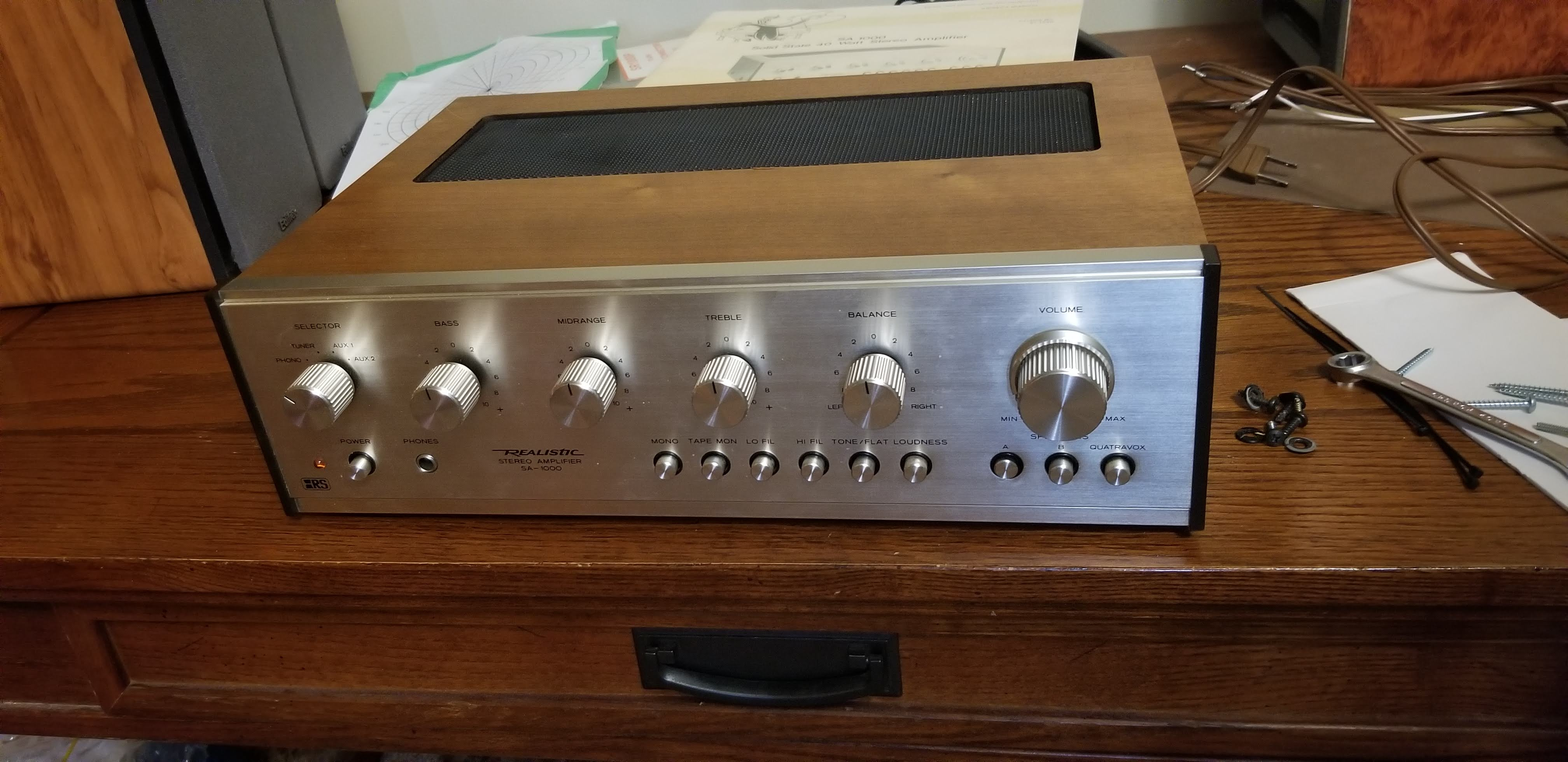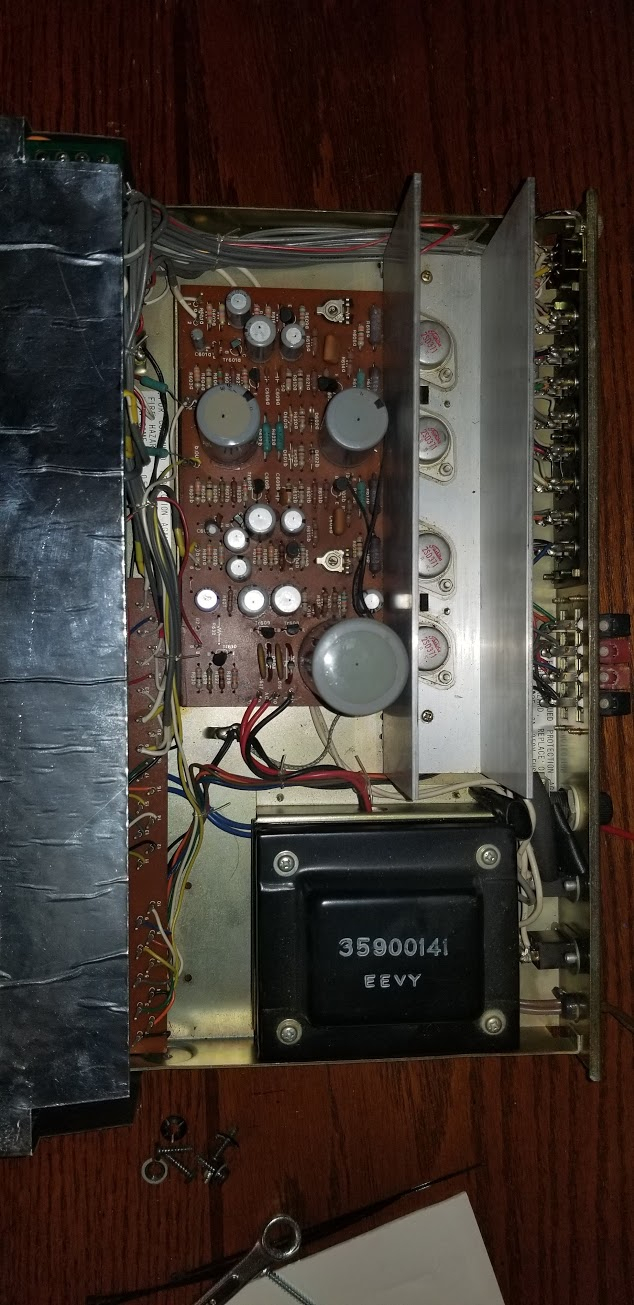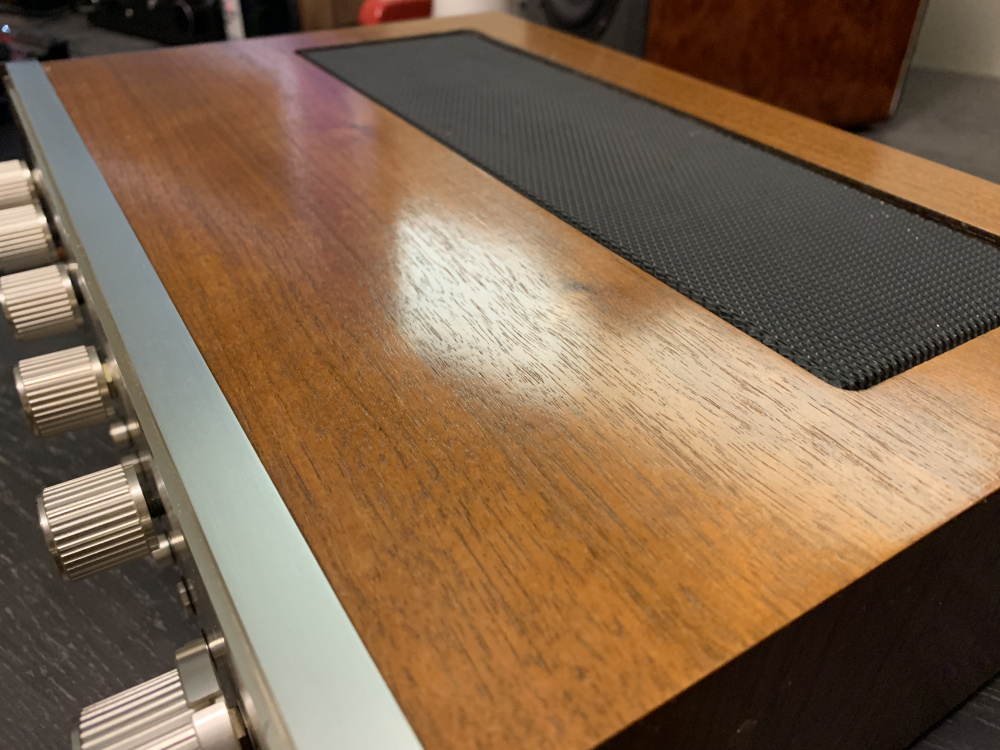Home ›
Site Links
Howdy, Stranger!
It looks like you're new here. If you want to get involved, click one of these buttons!
Quick Links
Categories
Who's Online (0)
An Old Friend ;)
My father has gifted me the receiver from my childhood 
It's a Realistic SA-1000, I used to listen to this with the matching Realistic tape deck or Elac turntable on a pair of Realistic Optimus-5 monkey coffins. The Optimus-5's I refurbished some time ago, re-used the 11" woofers and replaced both midrange and cone tweeter with a single Vifa TG9 and new crossover. They're still in use and sounding pretty good.
This amp isn't the most hifi thing out there, but for nostalgia sake I'm going to breath some life back into it. It's still working, but the knobs and buttons are scratchy, so I'm going to try and find replacement pots and replace a bunch of the caps while I'm at it. It's only a 20Wpc amp, with a single rail power supply so the amp output is capacitor coupled. Just replacing those two coupling caps will probably make it sound like new again I'm sure. It's easy to work in, single sided boards and before the invention of pcb connectors apparently, all the internal wiring is wire-wrapped. My dad kept the manual and even the purchase receipt, great thing is the manual has a complete schematic on the back page.
Looks pretty okay if you ask me, doesn't have VU meters unfortunately, but does have 3 band EQ, loudness button and "Quatravox"!



I'm not deaf, I'm just not listening.








Comments
InDIYana Event Website
I feel ya, that's a cool vintage system ya got !!! 🤘🏼
I know I've run into a few older pieces that use threaded collar nuts that screw on the pot to secure the faceplate. I don't know if those still exist, but it might be a simple project if you have a 3d printer.
Wow, I didn't realize it had been 2 years since I started work on this amp. I found that although it "Worked", there was something wrong with it. It clipped one side of the waveform at only about 2W of output. Internally there are several locations where should find 25-30VDC, but was only getting 10-12V. I shelved it at the time since the problem wasn't immediately obvious.
Yesterday I took another stab at it and found a bad resistor. No sign of burn or damage, but measured open circuit which was part of the voltage regulation for the smaller transistors.
Now it is all re-capped and back in service. I didn't find any replacement pots, but gave the pots and switches a good cleaning and they are working like new again. Power light needed replacing too, found a 12V automotive dash light bulb that fit perfectly as a replacement. I'll need to find some replacement for the speaker terminals at some point as the old plastic is crumbling away, otherwise this old amp should be good for another 30 years of service
Very cool that you got it running properly again!
I love the 60s & 70s era gear because it reminds me of a time when you could go to the record store or hifi shop and meet other music lovers who would turn you on to a new (or old) artist or band.
This amp spent many years playing records from an ELAC turntable of equal age. If you're interested, the original receipt says this amp was purchased in 1974 for CAD$200. According to online inflation calculators, that equates to CAD$1056 today.
I like the sound of amps with cap coupled outputs.
Good to see that you finally got this repaired and playing music again. I have an old Realistic STA-45B stereo receiver that I bought in 1970 that needs pretty much the same treatment. One of these days . . .
One of these days I'll put my little Pioneer SX-535 back on the bench again. Bought it cheap knowing one channel in the phono stage was a bit lower than the other. I replaced some suspect transistors, but that didn't solve the issue. Hearing about your normal looking but open resistor tells me I need to poke around again and see if I have a similar issue hiding in plain sight.
Input selector is a physical switch on these old units, it could be as simple as just needing a spray with contact cleaner.
Most people will use that Deoxit stuff, but it's not "off the shelf" where I am, so I used some CRC QD Electronic cleaner, then added a drop of 3-in-1 oil as a dielectric protection because its what I have on hand.
Another use for the measurement jig. 2-channel here isn't the key, but simply we are feeding the speaker level output into the audio interface input for signal analysis.
The SA-1000 includes a couple bias adjustment pots, presumably to reduce crossover distortion. The schematic simply points to a couple various DC voltages around the pots, but here's a better way. Here I simply connected the measurement jig to the amp, and used ARTA spectrum analysis. 1kHz tone generated, and exponential averaging to minimize noise. Then I simply adjusted the pot for minimum distortion products. The key here is to run a loopback test with your equipment to see where the harmonics sit before interting the amp into the equation. In my case, the 3rd harmonic here is approaching the minimum that I can reliably measure.
It would be really great if ARTA would allow to set some markers so you could monitor specific frequencies, in this case I would set a marker at each harmonic, but it doesn't appear to be that advanced of a spectrum analyzer.
If it's not evident from the graph, this old amp has a "warm" sound, it provides some of that tube-ish sound while still being a nice reliable solid state piece of equipment. Win win for that "vintage" sound
A coat of Danish oil has brought some life back into the case.

The last thing I will do with this is try and replace the speaker terminals with something that isn’t turning to dust, and possibly replace the power cord as well, for safety.
So did the pot w loudness tap pan out, you never said if it did.
InDIYana Event Website
Oh I didn't install it. Decided to just use what was in there as-is with a good cleaning.